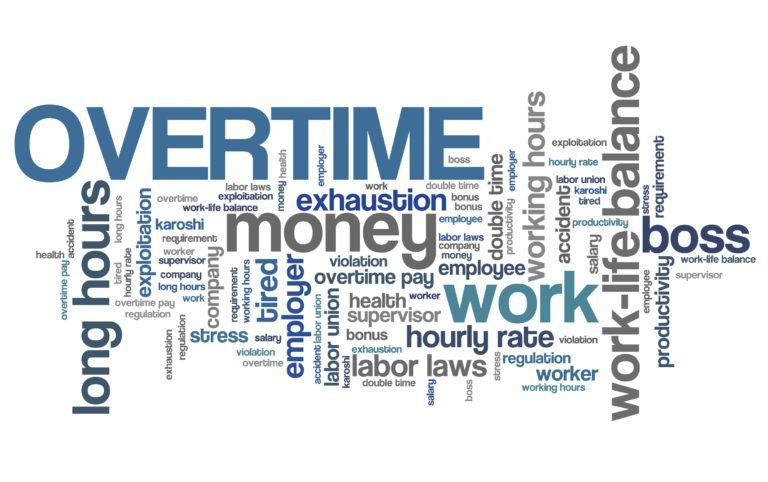CLIENT LOGIN
×PRACTICE AREAS
SUBSCRIBE TO OUR NEWLETTER
Contact Us
We will get back to you as soon as possible.
Please try again later.

What is overtime pay?
Overtime pay is compensation received for hourly work performed that is beyond the minimum of 40 hours per week. It is computed at “time and a half” meaning, your hourly rate plus 50% comprises your overtime pay for every hour worked beyond 40 hours each week.
Who gets overtime pay? Who doesn’t?
Under the rules in force since 2004, blue-collar workers such as those who work on an assembly line or those who work in retail stores or fast food restaurants get overtime pay as long as their basic salary did not exceed $26,660 a year. They get paid hourly wage for the first 40 hours of work each week, and every hour worked beyond that is paid 1.5 times higher.
Did you know, though, that since 2004, white-collar workers don’t get overtime pay? Yes, employees who perform work in an administrative, executive or professional capacity and receive an annual salary of not less than $26,660 do not get overtime pay even if they work more than 40 hours a week.
The Final Rule on Overtime Pay is meant to correct the situation where salaried employees who work beyond 40 hours every week but are not paid overtime are paid a salary rate that has been fully eroded by inflation.
What is the Final Rule on Overtime Pay?
In 2014, President Obama directed the Department of Labor to review the pay of white-collar workers in accordance with the protections provided under the Fair Labor Standards Act. The Department of Labor complied with the President’s directive and on July 6, 2015, it published a Notice of Proposed Rulemaking in the Federal Register. The proposed rule was published online where anyone could post comments. There were 270,000 comments on the proposed rule. On May 18th this year, President Obama announced that the Final Rule is set to take effect on December 1, 2016.
Under this new rule on overtime pay, the Department of Labor has raised the threshold annual salary from $26,660 to $47,476. This means that if you are a salaried employee who performs administrative, executive or professional duties, and you earn less than the threshold of $47,476, you will be entitled to overtime pay.
Why was this new rule adopted?
The threshold salary of $26,660 needs to be adjusted to allow for inflation. Some blue-collar workers get higher take home pay than salaried, exempt employees because they get overtime pay for the work they do beyond the minimum of 40 hours per week. This has been deemed inconsistent with spirit of the Fair Labor Standards Act law.
The proposed salary threshold was originally upwards of $51,000 annually because this accurately reflects the same buying power that $26,660 had in 2004. Under the Final Rule, the salary threshold is $46,476.
How does this affect you?
Well, if you are a salaried employee performing work in an administrative, executive or professional capacity, but your annual pay is lower than $47,476, and your employer does not raise your salary to meet the new threshold salary come December 1, 2016, every hour you work in excess of 40 hours a week will be considered overtime work and you will be paid the overtime rate.
If your salary is below the minimum threshold of $46,476, your employer can keep your salary as is even if it is below the annual salary threshold, but limit your workweek to only 40 hours. This means that you won’t need to work longer than 40 hours each week.
Of course, your employer can also raise your salary to meet the $47,476 annual threshold in order for you to continue working overtime hours. That means that you will get a salary bump from $455 (or more) per week to $913 (or more) per week under the Final Rule on Overtime Pay.
Who will benefit from this new overtime rule?
The new rule will benefit those workers who are currently exempt from being paid overtime but work overtime just the same (without additional compensation). There are about 4.2 million workers in this position. Fifty-six percent of these workers are women; 53 percent are college-degree holders; 61 percent are aged 35 or older. 1.5 million of these workers are parents.
They now will either enjoy a higher salary; or remain at the salary they now receive but they will be paid overtime for every hour worked in excess of 40 hours. The benefit is either bigger pay or more reasonable hours.
Whether you’re an employee who needs advice on how the Final Rule may affect you, or you’re an employer who needs help preparing for the December 1, 2016, deadline to ensure compliance, call us and we will be happy to discuss how these changes and possible scenarios apply to your workplace.
References:
Share this post to social media...
Contact Us
We will get back to you as soon as possible.
Please try again later.
© 2021 Saenz & Anderson. All Rights Reserved.


